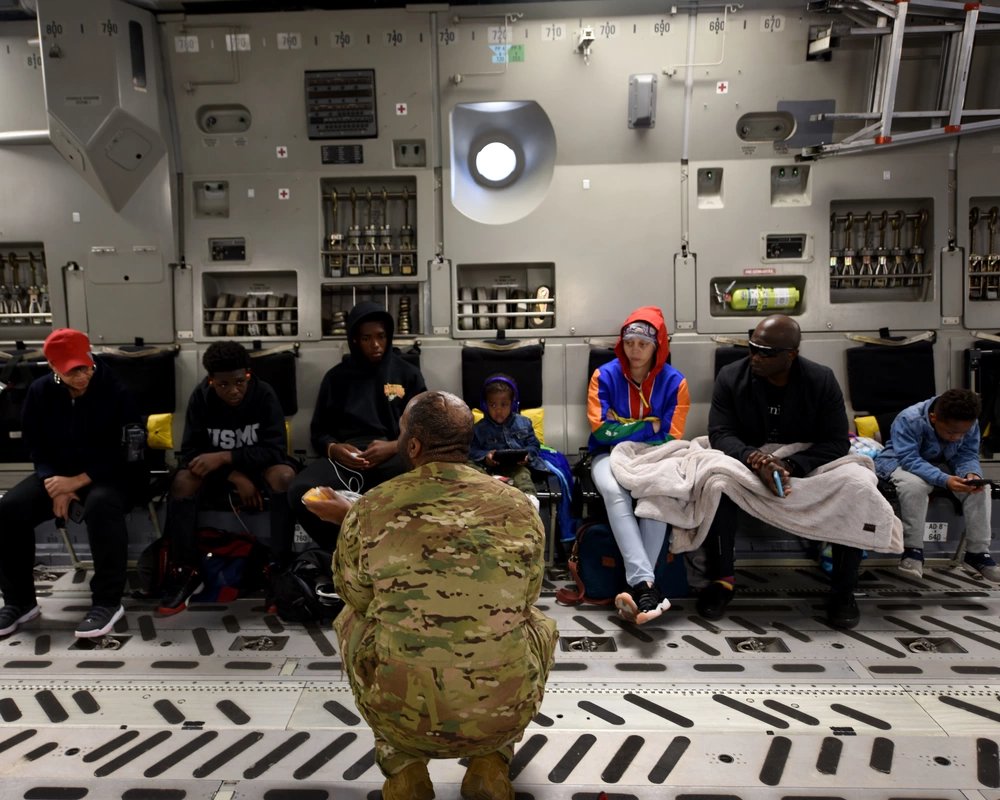

Ready to jet-set around the world without emptying your wallet? Let’s dive into the ins and outs of Space-A travel so you can start planning your next adventure.
Here’s everything you need to know about Space-A travel:
What is Space-A Travel?
Space-Available (Space-A) travel is a perk that allows eligible passengers to fill unused seats on military aircraft. Think of it as the military’s version of standby flights. It’s a fantastic opportunity to explore new places, but it has its own rules and quirks.
Who can use Space-A travel?
Whether you’re traveling with your service member or solo (with the right paperwork), you can take advantage of this benefit. Eligibility includes:
- Active duty military members
- Dependents
- Retirees
- Reservists and National Guard members
Preparing for your journey

Getting ready for your adventure starts with a little prep work before you even pack your bags. There are a few essentials that need to be sorted out ahead of time to make sure everything goes smoothly.
First, gather all the necessary documents. Your military ID should be up-to-date and valid, so make sure to check that it hasn’t expired. If you’re traveling with your service member, have a copy of their leave orders on hand. However, if you’re heading out without them, you’ll need a command sponsorship letter signed by their commander that authorizes you to fly solo. For any international trips, it’s crucial to have your passport and any necessary visas ready. Double-check the entry requirements for the country you’re visiting so there are no surprises at the border. You might also need a travel authorization letter, especially if you’re traveling alone as a dependent, and it’s always better to have it just in case you need it.
Understanding categories and priorities
Understanding how the Space-A categories work is also super important. Space-A travel operates on a priority system, so knowing which category you fall under helps you figure out your chances of getting a seat. For instance, Category I is reserved for emergency leave, while Category II covers accompanied environmental and morale leave. Category III is for those on ordinary leave or house hunting, and Category IV is for unaccompanied dependents on environmental and morale leave. If you’re traveling without your spouse, you’ll most likely be in Category V, which is typically where students, dependents, and others fall. Lastly, retirees fall under Category VI. Being aware of your category can help manage your expectations and make the whole process a little less stressful.
How to Sign Up for Space-A Travel
Start by checking out the flight schedules from your nearest military passenger terminal. You can:
- Visit the terminal in person.
- Check their official website.
- Follow their Facebook page for updates.
Terminals often post a 72-hour flight schedule, which is super helpful for planning.
Register for a flight
You can sign up for Space-A travel in several ways:
- In Person: Go to the passenger terminal and fill out a form.
- Email: Send an email to the terminal’s Space-A email address with your details and attach scanned copies of your documents.
- Fax: Old school, but it works. Fax your information and documents to the terminal.
Make sure to include:
- Your full name as it appears on your ID.
- Rank or dependent status.
- Branch of service.
- Number of seats you’re requesting.
- Destinations you’re interested in.
- Contact information.
Confirmation and date-time stamp
After registering, you’ll receive a confirmation with a date-time stamp. This timestamp is crucial because it determines your spot on the list within your category. The earlier you sign up, the better your chances.
Tips to increase your chances
Avoid peak seasons like summer PCS moves (May to August) and major holidays. Mid-week flights often have more availability. Flexibility with your travel dates can significantly improve your odds.
Flight schedules can change rapidly. Check Terminal Facebook pages for real-time updates. It’s also a good idea to join Space-A travel groups, where fellow travelers share tips and information.
Arrive at the terminal at least two hours before the scheduled roll call. Bring all your documents and be ready to go. Remember you’re not flying commercial, so you’ll need to pack light and bring all your carry-on essentials. There won’t be a meal service. Depending on the aircraft, you may be in webbed seating along the sides of the aircraft. There are no flight attendants or in-flight movies, either! The seats aren’t the most comfortable, so you might want to bring a blanket or a small pillow. Flights can be chilly, so dress in layers.
Be prepared for changes. Flights can always be delayed or canceled. It’s best to have a backup plan or a flexible timeline. Space-A travel is unpredictable, but that’s part of the fun. You’ll collect stories, meet interesting people, and maybe even discover a new favorite destination. With a bit of preparation and a flexible mindset, you can turn the challenges into unforgettable experiences.
